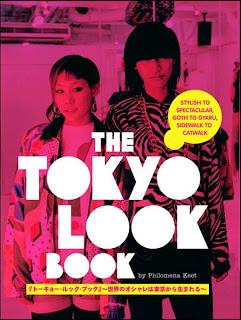The Tokyo Look Book, by Philomena Keet and Yuri Manabe
Oct 29
2007

With text by anthropologist Philomena Keet and pictures by Yuri Manabe, The Tokyo Look Book attempts to give readers a complete tour of the Tokyo fashion scene. While it doesn’t quite manage to cover the “entire spectrum of styles currently gracing the streets of the city” (which would probably require more than 220 pages), Keet and Manabe’s book is full of informative content and eye-catching, jaw-dropping pictures.
The Tokyo Look Book takes readers on a journey through the streets of Tokyo’s most fashionable districts, capturing looks ranging from Gothic Lolita and decora-kei to the carefully groomed styles worn by young professionals. In addition to the full-color photographs and Keet’s commentary, the book includes a handful of interviews with some of Tokyo’s leading fashion figures: boutique owners, magazine editors, and designers.
While it would have been a crime to cut any of Manabe’s photographs, The Tokyo Look Book might have been improved by additional commentary from Keet, whose brief descriptions raise more questions than they answer. How do these young people, a collection of students, salespeople, hosts, and hairstylists, afford to buy clothes that cost hundreds—sometimes thousands—of dollars? (And how do they clean them? We are talking about astronomical dry-cleaning bills, here.) Is it because life in a major urban center rules out rent and car payments? Are service workers exceptionally well paid in Japan? Traditional kimonos seem to be even more expensive—have the Japanese always devoted large chunks of their paycheck to clothing? None of these questions are answered, and they become more irritating with every chapter.
Happily, the little text that does exist in The Tokyo Look Book is a perfect fit for the book’s photographs. Keet’s dry, academic sentences balance out Manabe’s flamboyant pictures, which might prove a little overwhelming on their own. (It’s difficult to describe the impact of a full-page photograph of a woman wearing a yamamba outfit—the closest I can come is “picture a lady dressed up as a Rainbow Brite’s trashier cousin”.) Together, Keet and Manabe have crafted a fascinating, colorful book that's sure to appeal to fans of both fashion and Japanese pop culture.
The Tokyo Look Book takes readers on a journey through the streets of Tokyo’s most fashionable districts, capturing looks ranging from Gothic Lolita and decora-kei to the carefully groomed styles worn by young professionals. In addition to the full-color photographs and Keet’s commentary, the book includes a handful of interviews with some of Tokyo’s leading fashion figures: boutique owners, magazine editors, and designers.
While it would have been a crime to cut any of Manabe’s photographs, The Tokyo Look Book might have been improved by additional commentary from Keet, whose brief descriptions raise more questions than they answer. How do these young people, a collection of students, salespeople, hosts, and hairstylists, afford to buy clothes that cost hundreds—sometimes thousands—of dollars? (And how do they clean them? We are talking about astronomical dry-cleaning bills, here.) Is it because life in a major urban center rules out rent and car payments? Are service workers exceptionally well paid in Japan? Traditional kimonos seem to be even more expensive—have the Japanese always devoted large chunks of their paycheck to clothing? None of these questions are answered, and they become more irritating with every chapter.
Happily, the little text that does exist in The Tokyo Look Book is a perfect fit for the book’s photographs. Keet’s dry, academic sentences balance out Manabe’s flamboyant pictures, which might prove a little overwhelming on their own. (It’s difficult to describe the impact of a full-page photograph of a woman wearing a yamamba outfit—the closest I can come is “picture a lady dressed up as a Rainbow Brite’s trashier cousin”.) Together, Keet and Manabe have crafted a fascinating, colorful book that's sure to appeal to fans of both fashion and Japanese pop culture.
Posted by: Julianka
No new comments are allowed on this post.
Comments
No comments yet. Be the first!